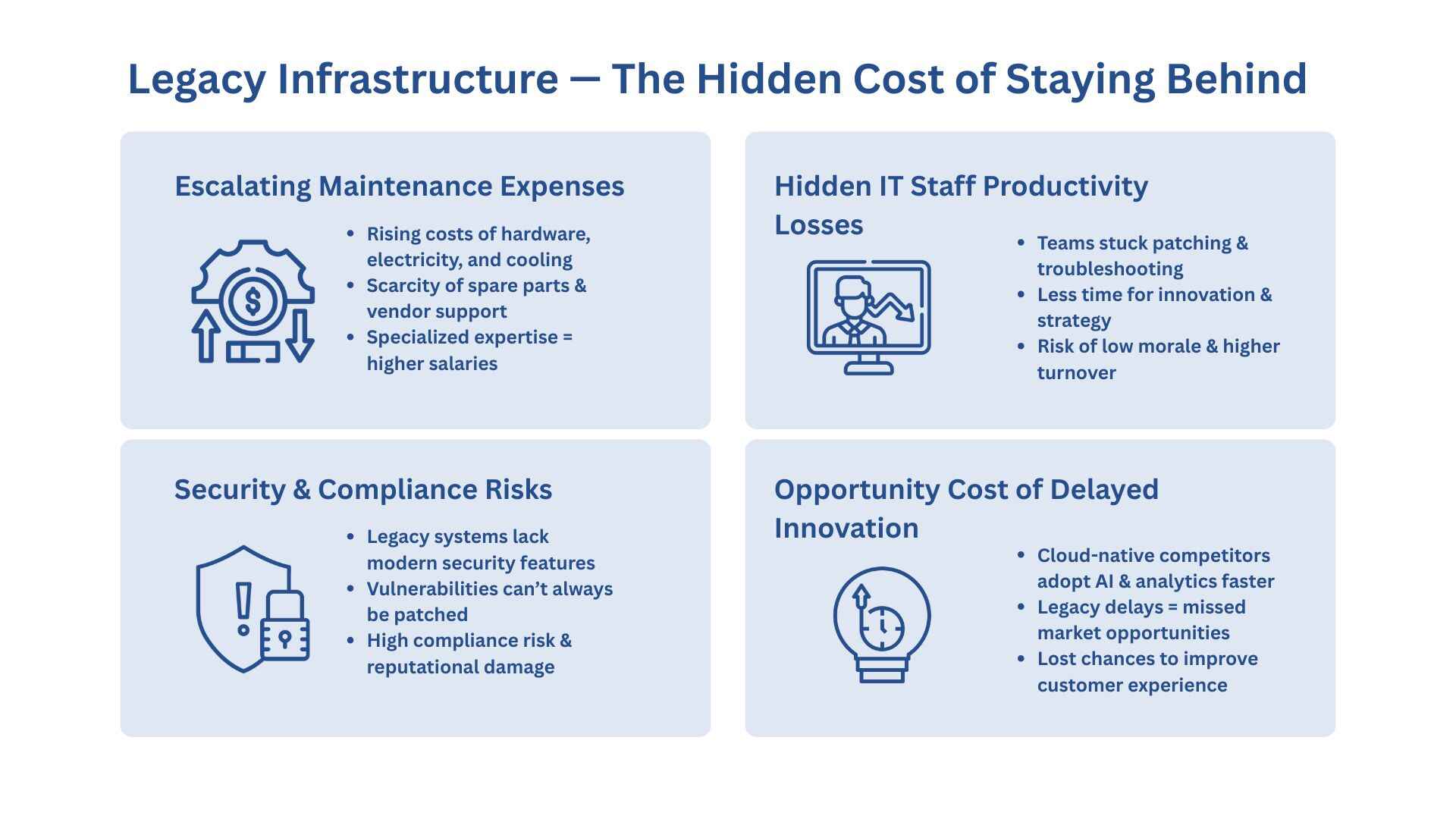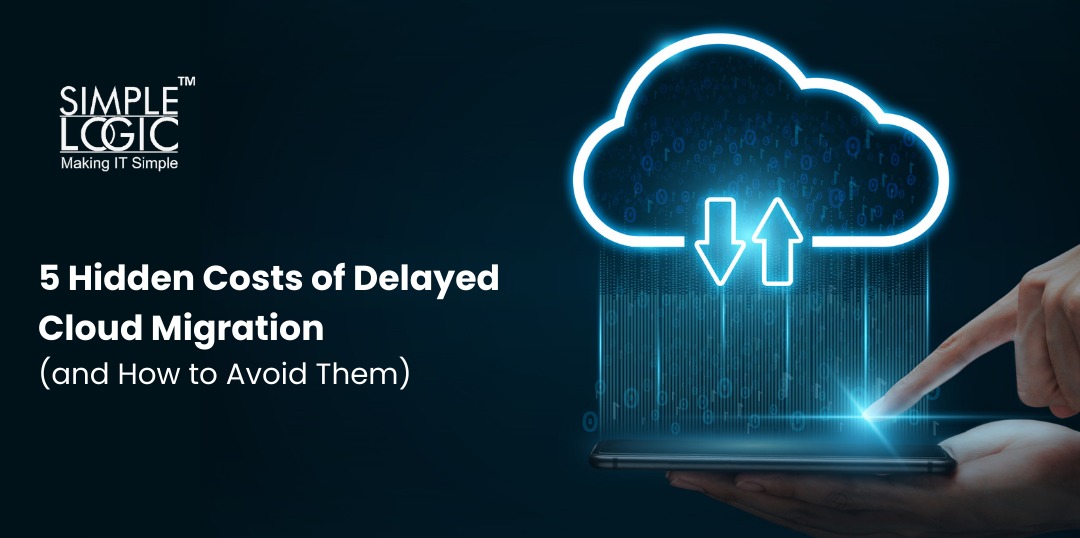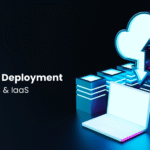Why Delaying Cloud Migration is More Expensive Than It Appears?
For many organisations, moving to the cloud sits somewhere between “important” and “we’ll get to it later” on the IT roadmap. It’s easy to justify postponement — there’s day-to-day business to run, budgets to manage, and the sense that legacy systems are “working fine for now”.Yet beneath the surface, each month of delayed cloud migration quietly adds hidden costs that rarely appear on standard financial reports. These often reveal themselves only when migration finally happens — by which point they’ve compounded into a far larger bill.
Cloud migration is not just a technical step but a strategic shift. It changes how an organisation operates, competes, and innovates. Delaying cloud migration can lead to mounting technical debt, inefficiencies, and lost opportunities that competitors quickly seize.
This article explores five hidden costs of delayed cloud migration and practical strategies to reduce them.
The True Cost of Outdated Infrastructure
Legacy infrastructure — the hidden cost of staying behind
Legacy infrastructure — whether physical servers in a data centre or older software platforms — is often the single most obvious reason for migration. But the real costs go beyond the equipment’s sticker price or an annual maintenance contract.
Escalating Maintenance Expenses for Legacy Systems
Maintaining older systems becomes more expensive over time.
Hardware components wear out, spare parts become harder to source, and vendor support often comes at a premium once equipment is no longer in its mainstream lifecycle.
Physical infrastructure demands constant spending on electricity, cooling, and security. These costs increase each year as equipment efficiency drops.
Cloud providers can deliver greater computing power without these physical overheads, thanks to economies of scale.
Specialised expertise is required to manage legacy systems. As these skills become rarer, salaries and contractor fees rise.
Hidden IT Staff Productivity Losses
IT teams spend excessive time maintaining legacy systems through patching, troubleshooting, and workarounds.
This time could otherwise be spent on innovation, improving business processes, and strategic planning.
Talented engineers or system administrators are stuck ensuring an ageing application doesn’t fail during critical reporting periods.
Over time, this leads to lower morale, higher staff turnover risk, and reduced agility within the IT department.
Security Vulnerabilities and Compliance Risks
Cyber threats and regulations constantly evolve, while legacy systems struggle to keep up.
Older platforms often lack support for modern encryption, multi-factor authentication, or real-time threat monitoring.
Some vulnerabilities cannot be fixed without major upgrades, even with regular patching.
Systems handling sensitive data face significant compliance risks, and delayed migration extends this period of exposure, risking financial loss and reputational damage.
Opportunity Cost of Delayed Innovation
While resources are tied up maintaining outdated systems, competitors leverage cloud-native tools to experiment with AI, analytics, and scalable services.
For instance, a retailer on the cloud can quickly deploy a personalised recommendation engine for a seasonal sale, while legacy-bound organisations may take months to trial similar features — missing key market opportunities.
The opportunity cost of delay means lost chances to gain market share, enhance customer satisfaction, and launch innovations ahead of competitors.

The Financial Impact of Technical Debt
Technical debt is a term often used by IT professionals, but its real-world financial impact can be underestimated at the business level. In simple terms, it refers to the cost of taking shortcuts today that must be paid for later — usually in the form of extra development work, higher maintenance demands, and reduced system performance.
When cloud migration is postponed, technical debt accumulates quietly. What begins as a few compromises or temporary fixes soon becomes an entire ecosystem of inefficiencies.
The Growing Cost of Patches and Workarounds
In legacy systems, “quick fixes” are often used to keep operations running.
For example, if an application doesn’t integrate with a new reporting tool, a manual data export might be introduced. Or if a payroll system struggles with overtime calculations, a spreadsheet workaround could be created.
These short-term solutions add complexity over time. The more patches and manual processes exist, the harder—and costlier—it becomes to migrate later.
When modernisation is finally pursued, the project must deal with untangling these dependencies, mapping them to new systems, and retraining staff.
Resource Allocation Inefficiencies
Technical debt not only increases workload but also diverts resources from strategic initiatives.
IT teams may spend hours each week troubleshooting avoidable issues instead of working on innovation.
Business users might also lose time correcting errors, re-entering data, or adjusting workflows to suit outdated technology.
This leads to a double loss — operational efficiency drops and chances for innovation are missed.
Reduced Business Agility
Cloud computing’s biggest edge is agility — the ability to scale resources, launch services, or adapt quickly to market shifts.
Technical debt slows this process down. Deploying a new customer portal could take days or weeks in the cloud, but months in legacy environments requiring testing and manual integration.
This delay can result in missed market opportunities.
For instance, during a sudden surge in demand, such as a product going viral online, cloud-based businesses can scale instantly, while companies burdened by technical debt may struggle to keep up — giving competitors the chance to capture the opportunity.
Competitive Disadvantage in the Digital Marketplace
In today’s economy, digital transformation isn’t a luxury — it’s a necessity. Customers, partners, and suppliers increasingly expect seamless, real-time interaction. Organisations relying on outdated systems face a widening gap between what they can deliver and what the market demands.
Losing Ground to Cloud-Native Competitors
Cloud-native companies are designed to leverage scalable infrastructure, advanced analytics, and automation from the outset.
They can roll out new features quickly, adjust pricing models in real time, and experiment with innovative ideas without long delays.
Organisations that delay migration risk losing relevance in their industry, with even established players being overtaken by more agile competitors.
Customer Experience Limitations
Today’s customers expect fast, personalised, and uninterrupted digital services.
Legacy systems struggle to meet these expectations — slow page loads, limited mobile functionality, and frequent downtime all degrade the experience.
Over time, this leads to reduced brand loyalty, as customers are quick to switch to providers offering smoother and more modern experiences. Winning them back once they leave is both costly and difficult.
Slower Time-to-Market for New Products
In competitive markets, being first to launch a new feature, service, or product can make all the difference.
Cloud platforms support faster prototyping, testing, and deployment, helping businesses hit the market sooner.
Without these capabilities, organisations risk missing key opportunities or entering the market too late to make an impact.
Reduced Talent Attraction and Retention
Technology professionals prefer working with modern tools and cloud environments.
Skilled developers, engineers, and analysts may avoid roles that require them to work solely on outdated systems.
This creates challenges in recruitment and raises costs, while also increasing turnover, as employees seek roles that offer greater professional growth.
Rising Costs of Eventual Migration
Delaying cloud migration doesn’t just maintain the status quo — it actively increases the future price tag of modernisation. The longer an organisation waits, the more complex and expensive the migration becomes.
| Factor Increasing Costs | Why It Matters | Example |
|---|---|---|
| More Data to Move | More storage, processing, and downtime required for larger datasets. | 3 years’ worth of extra transactional data significantly slows migration. |
| Increasing System Complexity | More tools, integrations, and dependencies to map and rebuild. | Custom integrations built over time create a “spaghetti” architecture. |
| Rising Cost of Migration Experts | Specialist demand exceeds supply, driving up rates. | Cloud architects are charging 30% more than last year. |
| Risk of Forced, Emergency Migration | Vendor support ends or breaches force urgent moves at premium cost. | Forced migration after security incident doubles project budget. |
Strategic Approaches to Reduce Cloud Migration Costs
While the risks and costs of delaying cloud adoption are significant, the good news is that there are proven cloud cost optimization strategies to reduce both the expense and complexity of moving to the cloud.
Adopt a Phased Cloud Migration Approach
Rather than attempting a “big bang” migration, breaking the process into smaller, phased stages offers better results.
High-priority applications can be moved first, reducing immediate risks while spreading costs and resource demands over time.
Each phase allows teams to learn from experience, improving efficiency and minimising errors in future stages.
Conduct a Cloud Readiness & Pre-Migration Assessment
A detailed cloud readiness assessment helps identify redundancies, inefficiencies, and unnecessary data before migration.
This reduces the amount of data to transfer, eliminates outdated processes, and ensures the new cloud environment meets both current and future requirements.
Addressing these issues early avoids expensive redesigns later in the migration process.
Invest in Cloud Training Programs for Staff
Migration isn’t just about shifting data; it’s about changing how systems are managed and how teams work.
Training IT staff and business users in cloud technologies before migration ensures smoother transitions, less downtime, and lower dependency on external consultants.
Well-trained teams can adapt quickly and maintain productivity throughout the process.
Align Migration Strategy with Business Objectives
The most effective cloud migrations are guided by clear business goals — whether that’s improving customer service, supporting remote work, or enhancing data-driven decision-making.
When migration aligns with organisational priorities, it’s easier to gain stakeholder buy-in, justify investments, and track the return on cloud investment (ROCI).
A business-focused approach ensures that migration efforts deliver tangible results.

Conclusion
Cloud migration is not just a technology decision — it’s a business-critical strategy that impacts competitiveness, security, and operational efficiency. While it’s tempting to delay such a significant undertaking, the hidden costs accumulate with every month of postponement.Outdated infrastructure demands more maintenance and energy, technical debt grows steadily, and competitors who adopt cloud solutions move ahead in innovation and customer service. The eventual migration, when it happens, is often far more expensive and complex than it would have been if tackled earlier.
However, by taking a proactive, strategic approach — including phased migration, thorough pre-planning, and early staff training — organisations can control costs and ensure a smooth transition. The cloud offers not only cost savings but also agility, scalability, and the ability to innovate faster.In a digital economy that rewards speed, adaptability, and customer focus, the decision to move sooner rather than later can be the difference between leading the market and falling behind it. The longer migration is delayed, the more an organisation pays — often without realising it.




